Most visitors don’t realize Page sits where the Colorado River secretly carved enormous red-rock sculptures just beneath the desert’s calm surface. You’ll find narrow slot canyons alive with shifting light, a river that bends like a painted ribbon, and a lake that hides arches and coves you can only reach by boat. I’ll guide you through the best viewpoints, water adventures, and quiet corners—so you can plan the stops that fit the kind of trip you want.
Antelope Canyon
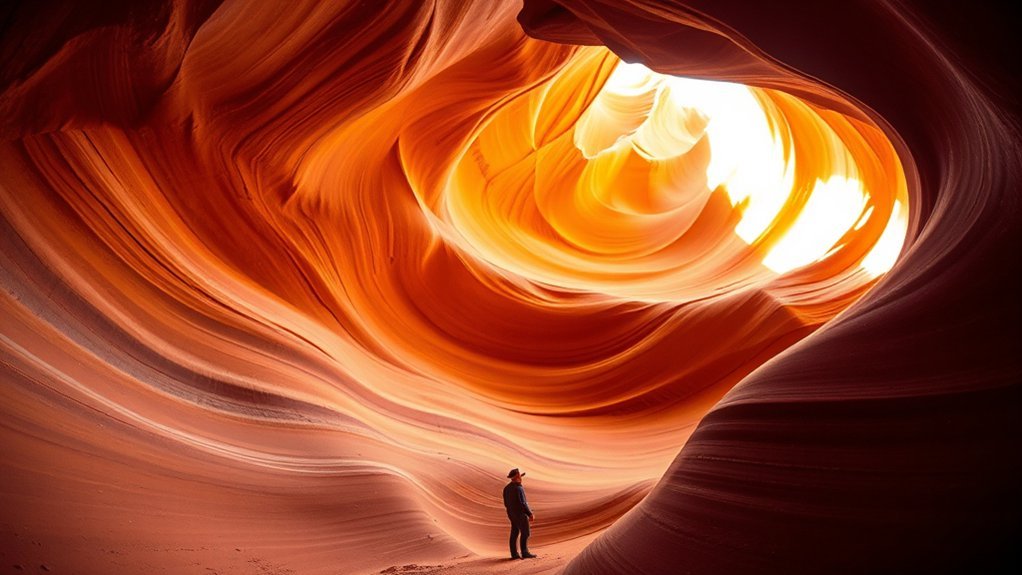
Ever wondered what it feels like to walk through light and stone? You step into Antelope Canyon and your breath shortens as sandstone walls fold around you like pages. Sunbeams slit the chamber at midday, turning dust motes into golden ribbons that seem to float in slow motion. You’ll follow a Navajo guide who knows each twist: where the corridors narrow, where the rock swirls into ribbons, and where a hidden alcove frames the sky. They’ll tell stories of water that carved these hollows over millennia and of cultural reverence that keeps the canyon protected. You’ll learn how to angle your camera, when to pause for silence, and why respectful behavior matters here. Time bends; your photos capture color gradients you didn’t know existed. When you emerge, sunlight feels different—brighter, tempered by memory—and you carry an intimate understanding of erosion, light, and the patience of stone.
Horseshoe Bend
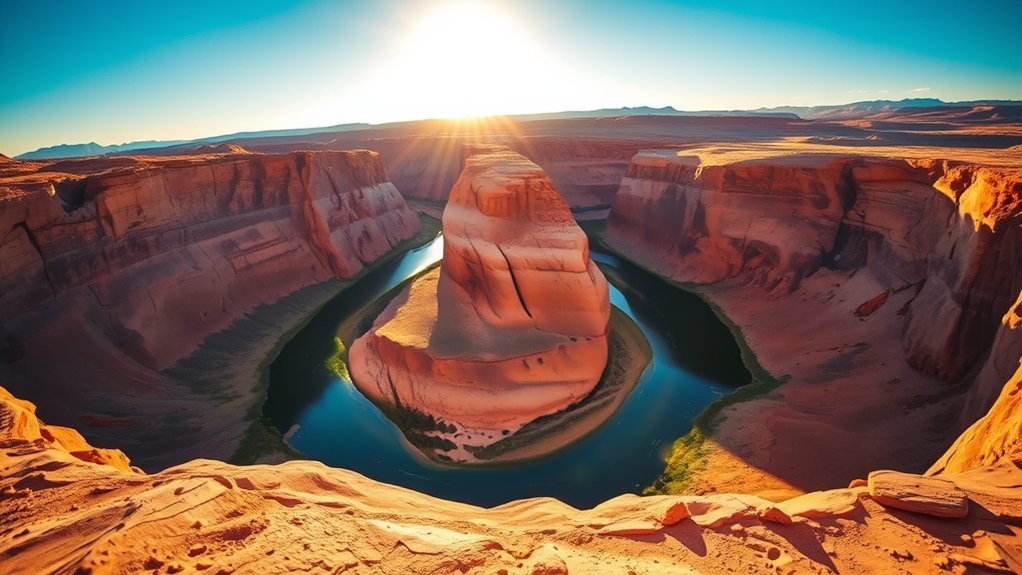
When you step onto the rim at Horseshoe Bend, the canyon opens beneath you in a sweep of copper and blue that’s best seen at sunrise or late afternoon when shadows paint the cliffs. Bring a wide-angle lens, steady your stance against the wind, and watch for changing light to capture the curve without cropping out the river; handheld shots can work but a tripod and ND filter will sharpen long exposures. Stay back from the edge, follow the railings and paths, and keep kids and gear secured—those cliffs are beautiful but unforgiving.
Best Time to Visit
Because light makes the view, plan your visit to Horseshoe Bend for early morning or late afternoon when the Colorado River and sandstone glow—sunrise gives soft, cool tones and smaller crowds, while golden hour paints the cliffs warm and dramatic. You’ll arrive as the air chills or cools, footsteps crunching on desert sand while the rim wakes with quiet. Midday brings harsh shadows and heat; you’ll feel the sun flatten textures and the place fill with tour groups. Spring and fall offer mild temperatures and blooming desert plants that add subtle color. Winter gives stark, crisp panoramas and thinner crowds but cooler winds. Choose timing that matches the mood you want—intimate calm, fiery color, or stark clarity—and you’ll leave satisfied.
Photo Tips and Safety
You’ve picked your moment—now make the images match it. Stand back from the rim, frame the curve, and let the Colorado River lead the eye. Use a wide lens for the bend, a telephoto to compress layers at dawn, and bracket exposures to keep highlights and shadows in check. Golden-hour light sculpts the canyon; blue-hour silhouettes feel cinematic. Secure your tripod on firm ground and mind the wind; a low tripod or sandbag steadies long exposures.
Safety’s part of the shot—stay behind railings, watch feet on crumbly sandstone, and never edge for a better angle. Tell someone your plan, carry water, and keep a headlamp for pre- or post-sun walks. Your best photo comes from calm, prepared choices.
Lake Powell Boat Tour
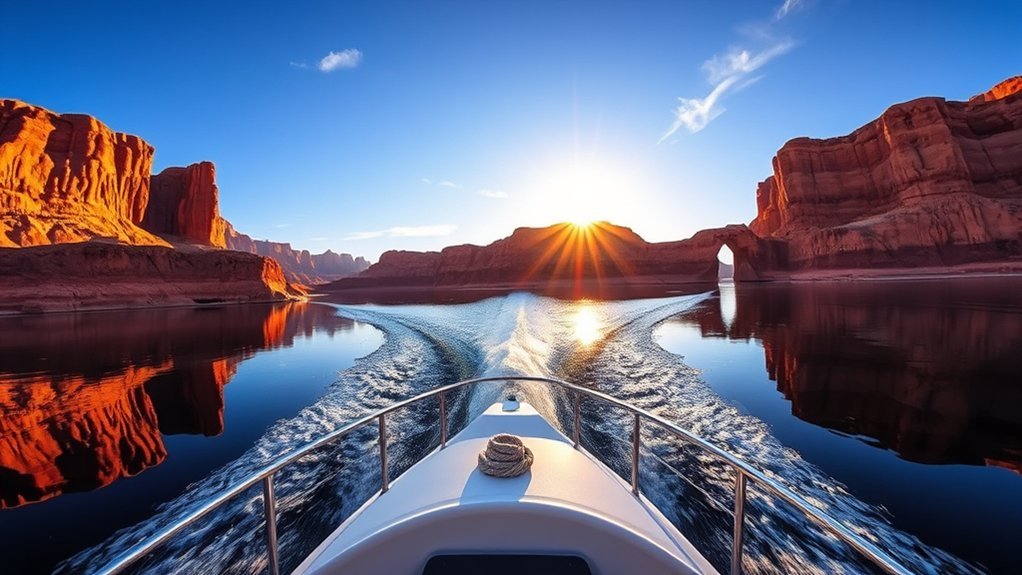
Hop aboard and let the canyon walls close in around you as the boat slips into the glassy expanse of Lake Powell—an immersive way to see Navajo sandstone cliffs, hidden alcoves, and quiet beaches that are otherwise inaccessible. You’ll feel the engine’s low thrum as sunlight paints the rock in honeyed stripes. Guides point out geological layers, small petroglyph sites, and the best swim coves; you’ll hear stories of water’s work and desert resilience.
- Choose a sunrise or sunset cruise for dramatic color and cooler temps.
- Pack water, sun protection, and a camera with a polarizer for reflections.
- Stop at secluded beaches to hike short trails or picnic in solitude.
- Book a private or small-group tour to access narrower side canyons.
Rainbow Bridge National Monument
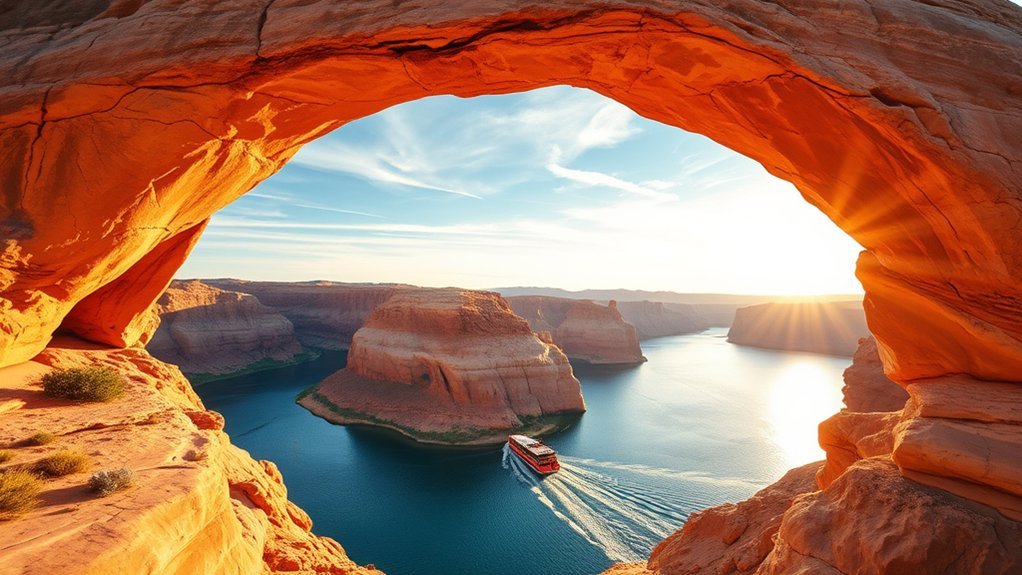
You can reach Rainbow Bridge National Monument by boat from Lake Powell or via a longer backcountry hike, and both routes reward you with a quiet, otherworldly arrival. As you stand beneath the 290-foot sandstone arch, you’ll feel the weight of its cultural importance to Navajo, Hopi, San Juan Southern Paiute, and other tribes who consider it sacred. Learn the access rules and respectful behavior before you go so your visit honors both the fragile landscape and its living cultural legacy.
How to Visit
Because Rainbow Bridge sits within a remote stretch of Glen Canyon and is only accessible by water or a long backcountry hike, planning your visit takes a bit more effort than dropping by most national monuments. You’ll choose between a boat tour, a private boat, or a multi-day paddle — each option shapes the rhythm of your trip. Expect early starts, permits, and sunscreen; the sun and reflections off Lake Powell are relentless. Bring plenty of water, sturdy shoes for the short shoreline walk, and a camera for the arch’s sudden reveal. Consider timing for softer light at dawn or dusk to capture the bridge’s warm tones and the quiet that makes the approach feel almost ceremonial.
- Reserve boat tour or launch permit early
- Pack water, snacks, sun protection
- Plan for a shoreline hike to the bridge
- Respect posted rules and stay safe
Cultural and Natural Significance
Though the arch’s sheer stone and sculpted span will grab your attention first, Rainbow Bridge carries deep layers of meaning for Indigenous peoples and geologists alike. When you approach by boat or trail, you’ll feel a sacred hush; Navajo and other nations regard it as a living spiritual place, woven into origin stories and seasonal rites. Scientists, meanwhile, trace its formation to river erosion and Navajo sandstone uplift, reading time in curves and joints. You’ll listen to both perspectives — elders’ reverence and researchers’ data — and sense how culture and geology converse.
| Aspect | Indigenous Significance | Geological Insight |
|---|---|---|
| Origin | Sacred kinship site | River-carved arch formation |
| Use | Ceremonial respect | Erosion timeline |
Glen Canyon National Recreation Area
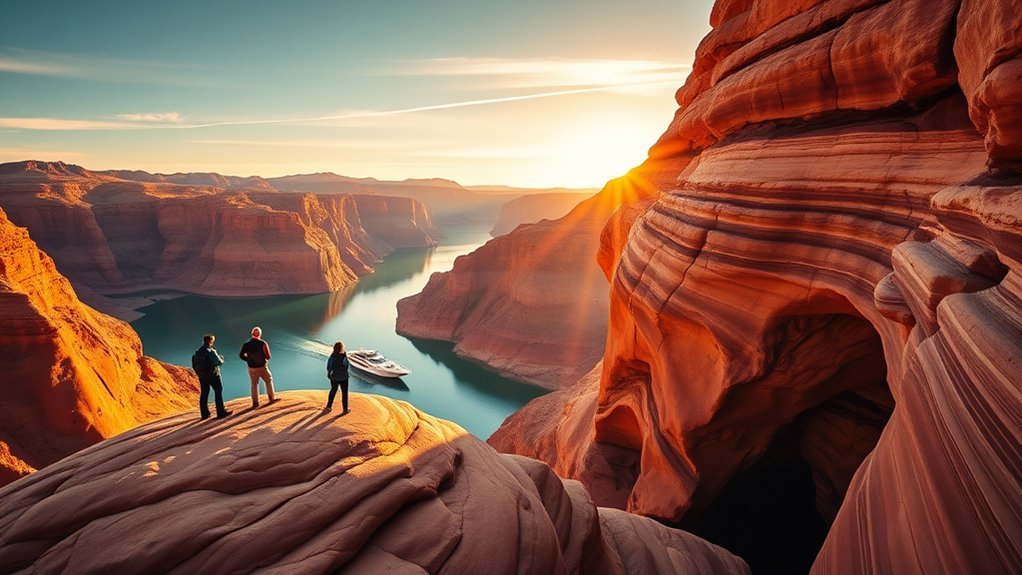
Often overlooked by visitors rushing to Antelope Canyon, Glen Canyon National Recreation Area rewards those who linger with vast blue water, sculpted redrock, and endless shoreline to explore. You pull into a quiet cove, feel the sun on sandstone, and suddenly the lake’s scale rewrites your plans: boating becomes a route into hidden canyons, paddleboarding turns into a close-up of fossil-lined walls, and shore hikes reveal petroglyphs and quiet viewpoints.
Linger beyond Antelope Canyon—Glen Canyon’s turquoise water, sculpted redrock, and silent coves reward slow exploration.
- Rent a boat to reach remote arches and slot canyons.
- Paddle or kayak at dawn for wildlife and serene reflections.
- Hike the shoreline to find secluded beaches and rock art.
- Camp under dark skies to watch geologic shadows shift at sunset.
You’ll leave with stories of turquoise water splitting red cliffs, of wind-sculpted formations that glow at golden hour, and of a landscape that rewards curiosity when you slow down and explore its many coves.
Vermilion Cliffs National Monument
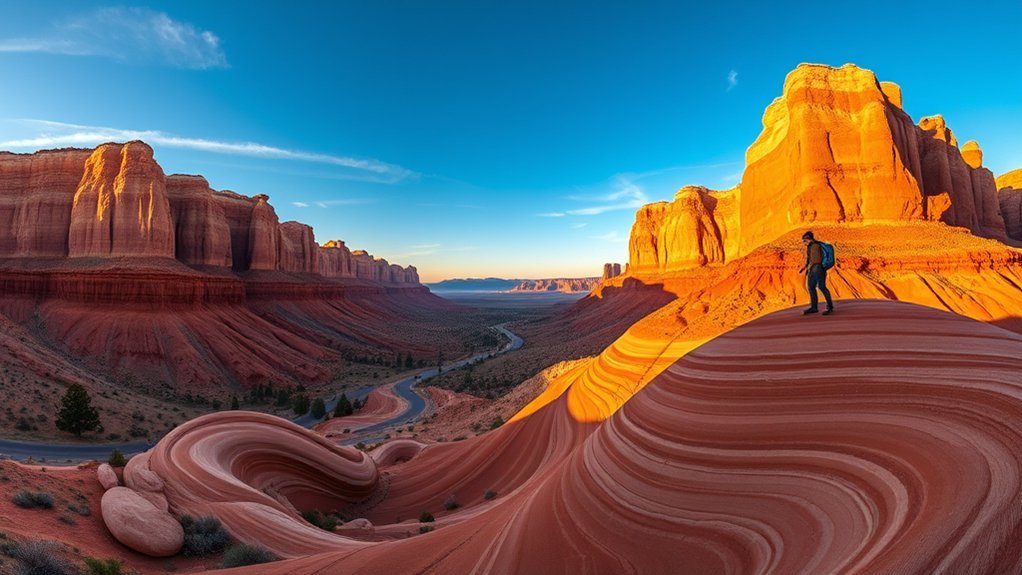
Just a short drive from Glen Canyon’s blue edges, Vermilion Cliffs National Monument reveals a different kind of awe—sheer, rust-colored walls, checkerboard mesas, and sweeping badlands that feel both ancient and intimate. You’ll feel small standing beneath the cliffs, tracing layers of stone that record millions of years. Hikes vary from short viewpoints to rugged routes where cairns mark a path across slickrock; bring plenty of water and sturdy shoes. If you’re lucky, you’ll spot California condors riding thermal lifts or bighorn sheep picking their way along ledges. Photography here rewards patience: dawn softens reds, while late afternoon throws long shadows that carve the landscape. Permits are required for certain areas, and access can be rough, so check road conditions and regulations before you go. Guided outings offer local geology and wildlife insight, but solo exploration also yields quiet discoveries—isolated washes, petroglyphs in hidden alcoves, and vistas that insist you slow down and look closer.
Lower Antelope Canyon Photography Tour
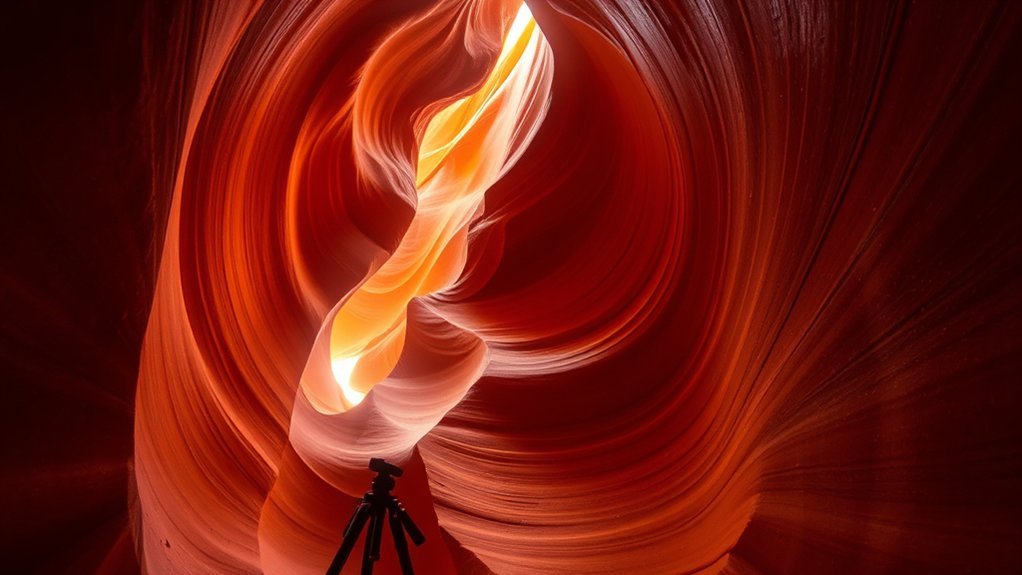
When you step into Lower Antelope Canyon with a camera, the light and sandstone shift like a living painting, so timing is everything—aim for mid-morning to catch the soft contrast before the midday shafts. Bring a sturdy tripod, wide-angle lens, and neutral-density or polarizing filters to manage exposure and keep your ISO low for crisp textures. As beams slice through the narrows, move slowly, watch angles, and be ready to frame the shafts against the curving walls to capture that iconic, luminous moment.
Best Time to Shoot
If you want the iconic beams and rich, warm tones that make Lower Antelope Canyon famous, plan your shoot for late morning—typically between 10:30 a.m. and 1:30 p.m.—when the sun sits high enough to pour angled light down the slot and illuminate the sculpted walls. You’ll watch shadows slide and colors saturate as the canyon breathes light into every curve. Aim for midweek to avoid crowds, and be ready to adapt to changing light through the hour. Think like a storyteller: anticipate moments when a shaft will land, then move to shape your frame.
- Visit late morning for beam opportunities.
- Choose midweek to limit visitors.
- Allow extra time for light shifts.
- Be patient—great shots often arrive slowly.
Camera Gear Essentials
Now that you know when the light will sing through the slot, think about the tools you’ll bring to capture it — the right gear lets you translate those fleeting beams into photographs that feel like stories. Pack a sturdy, compact tripod for long exposures and low ISO clarity; the canyon’s uneven floor rewards stability. Bring a wide-angle lens (16–35mm) to embrace sweeping curves, plus a 24–70mm for tighter compositions. A polarizer can reduce glare on sandstone, while a neutral density filter helps balance bright entrances with shadowed recesses. Carry extra batteries and fast cards — cold, dusty conditions drain power and fill memory. Protect gear with a lightweight rain/ dust cover and a microfiber cloth; you’ll want clean, ready glass when the canyon reveals its next secret.
Navigating Light Beams
Although the beams seem to appear by magic, you’ll find they follow a reliable script tied to the sun’s angle, the canyon’s openings, and a few subtle weather cues; learning that script turns fleeting shafts into repeatable opportunities. You step into cool sandstone corridors, watching light carve the walls. Anticipation matters more than luck: guides read sun position, clouds, and dust to predict when a shaft will pierce the chamber. Position yourself, brace your tripod, and let the canyon reveal textures that only light can etch.
- Time it: late morning in summer yields strongest beams.
- Watch weather: thin clouds can soften or diffuse shafts.
- Angle: move laterally to change beam width and wall highlights.
- Patience: wait for dust motes to animate the light.
Upper Antelope Canyon Guided Walk
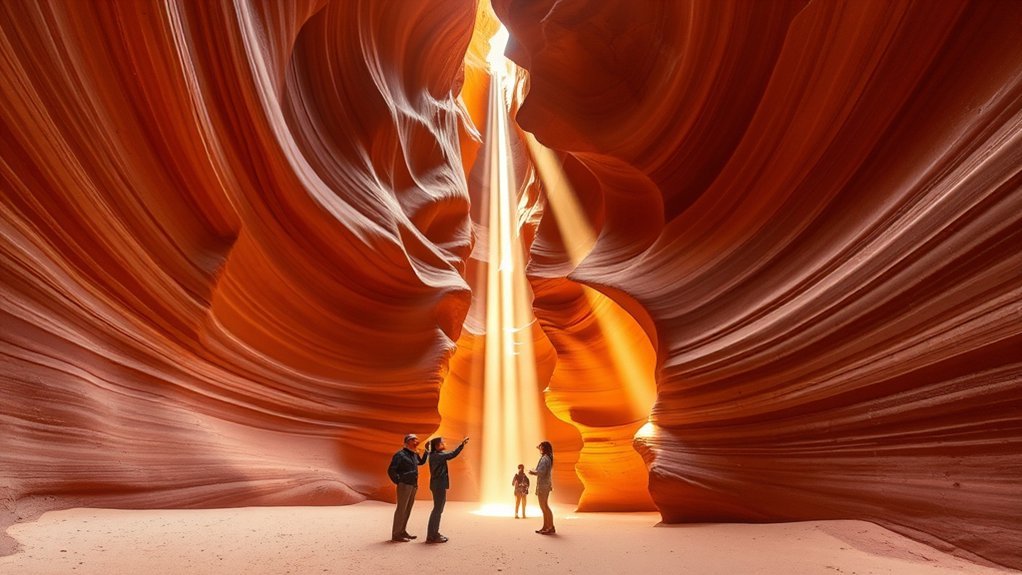
Tucked beneath the red sandstone cliffs just outside Page, the Upper Antelope Canyon Guided Walk drops you into a narrow, sunlit world carved by water and time; as you step in, light shafts and rippling walls shift with every footfall, turning the canyon into a living, sculpted gallery. You follow a Navajo guide who reads the stone like a story, pointing out ancient flood lines and whispering how each curve formed. Your camera will crave the contrast of bronze and sky-blue slivers; your skin will remember the cool shade. Walk slowly, breathe the dry, mineral air, and let the canyon reveal tight chambers and sudden openings that frame the sky.
| Texture | Mood |
|---|---|
| Smooth, undulating striations | Reverent, hushed |
| Polished alcoves | Curious, intimate |
| Narrow passageways | Adventurous, contained |
| Light shafts breaking through | Dramatic, fleeting |
Tours run by time of day; book ahead, follow your guide, and respect this fragile, sacred place.
Glen Canyon Dam Visitor Center
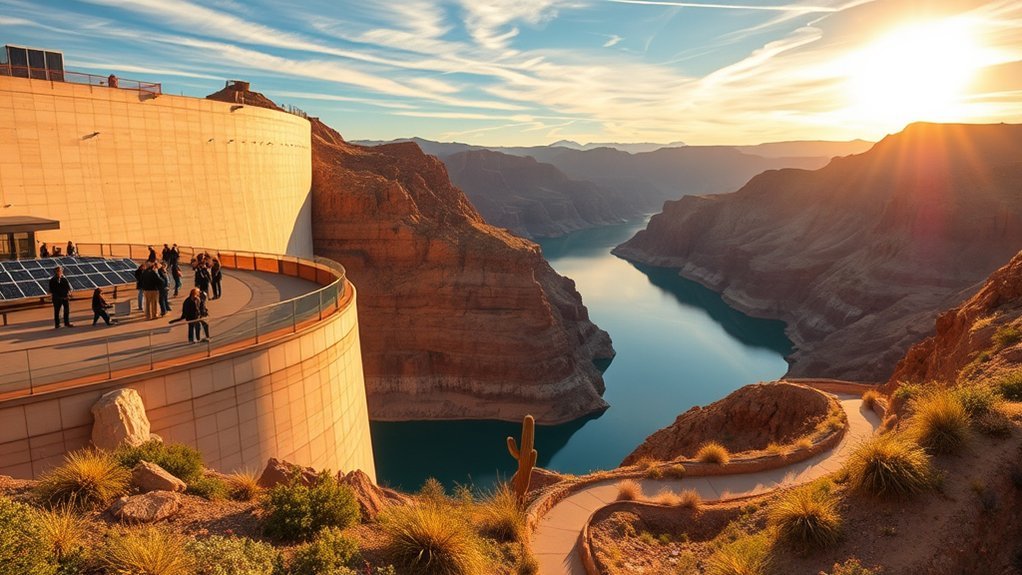
Perched above the Colorado River, the Glen Canyon Dam Visitor Center invites you to peer into the engineering heart of Page and the story of water in the Southwest. You walk in and immediately sense scale: massive concrete, humming turbines, and displays that map how water reshaped this landscape and communities. Docents share human stories—river runners, engineers, and Navajo voices—so you understand consequences, not just construction.
- Guided exhibits explaining dam construction and hydroelectric power.
- Observation windows framing the spillway and powerplant activity.
- Interactive displays on water management, ecology, and regional history.
- Short films and ranger talks that place the dam in modern context.
You’ll linger by the overlook to watch barges and river currents, then step into quieter panels about conservation and future water challenges. The center balances awe with responsibility, leaving you informed, reflective, and ready to explore Page with a deeper sense of place.
Wahweap Overlook
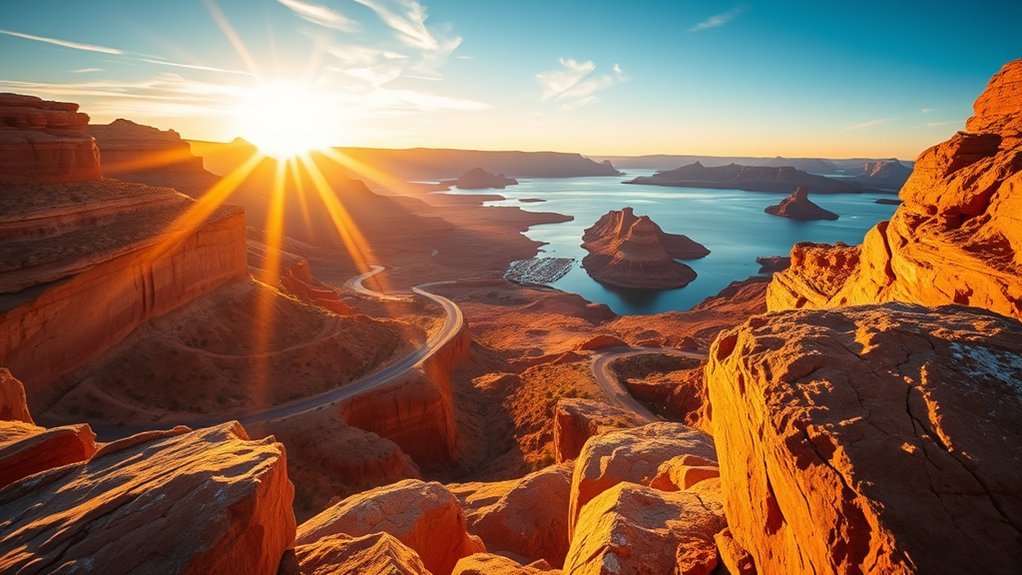
From the visitor center’s overlook you can follow the river’s curve downstream to Wahweap Overlook, where the landscape opens into a broader sweep of red mesas and glittering water. You arrive quickly—park, step onto the viewing platform, and feel the scale: Lake Powell’s blue slices against rust-colored cliffs, boat wakes knitting the surface. Binoculars pull distant houseboats into focus; hikers look like tiny ants traversing benchlands. You’ll want to linger through changing light as clouds cast moving shadows across sandstone ribs. Informational panels explain Navajo Nation geography and reservoir history, so you’ll understand what you’re seeing: ancient layers uplifted and cut by water and time. Photographers find compositions at every angle, from tight rock textures to panoramic sky. If you’re timing a sunset, plan to stay; temperatures drop fast but colors deepen. Pack water, sun protection, and respect posted boundaries—this is a fragile, storied landscape that rewards quiet attention.
Hanging Garden Trail
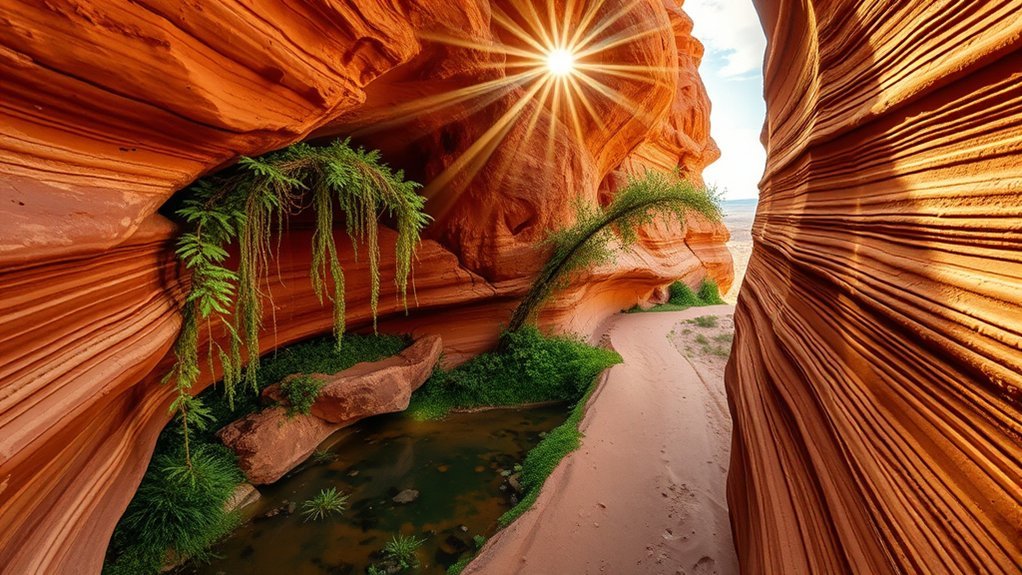
Start at the small parking area off the rim and follow the narrow switchbacks that make the Hanging Garden Trail a short but rewarding route, roughly a half-mile out-and-back depending on how far you wander. In spring and after monsoon storms you’ll often hear trickling water and see lush vegetation clinging to the cliff, while in dry months the canyon feels more arid and quiet. Watch your step on uneven rock, carry water, and check seasonal access rules since flash floods and trail closures can change plans quickly.
Trail Route and Distance
Although the Hanging Garden Trail is short, you’ll find its route deceptively varied: a half-mile loop that drops from the rim into a shaded pocket of canyon before climbing back up along sandstone ledges. You’ll start on a worn path, descend stone steps carved by boots, and feel the canyon tighten as walls hush the wind. The switchback climb rewards you with sweeping views of the mesa you left behind. Pace yourself—it’s brief but concentrated.
- Trail length: ~0.5 miles loop, easy to moderate.
- Elevation change: ~50–70 feet; steady but not steep.
- Terrain: compact dirt, exposed sandstone ledges, carved steps.
- Time: 20–40 minutes depending on stops.
Bring good shoes and take small, deliberate steps.
Seasonal Water Flow
After you’ve climbed back onto the mesa, you’ll notice the hanging garden’s character can change with the seasons—what feels like a dry, sunbaked alcove in late summer can sing with trickling water in cooler, wetter months. You’ll watch moss deepen to emerald, hear tiny streams weave through sandstone, and feel cooler air as plants drink and release moisture. The trail becomes a living portrait: birds return, light filters through dripping fronds, and the scent of damp earth sharpens memory. Timing matters — visit after monsoon showers or winter melts to see the garden at its most vivid. Below, a simple table captures what you might feel, see, and hear on different days.
| Feel | See | Hear |
|---|---|---|
| Cool mist | Emerald moss | Trickle |
| Dry warmth | Cracked stone | Silence |
| Fresh air | Dripping fronds | Birdsong |
Safety and Access Tips
When you approach the Hanging Garden Trail, pay close attention to footing and weather because slick sandstone and sudden runoff can turn a short scramble into a risky one. You’ll watch clouds build, smell damp earth, and choose your line carefully as water shapes the path. Expect narrow ledges, shallow pools, and a few low climbs that reward you with dripping ferns and quiet shade.
- Check forecasts — avoid the trail during storms or flash-flood warnings.
- Wear grippy shoes and bring trekking poles for balance on smooth rock.
- Stay on marked routes to protect fragile vegetation and avoid loose edges.
- Pack water, a headlamp, and a whistle; cell service can be spotty.
Move deliberately, respect clues from the landscape, and turn back if conditions deteriorate.
Lone Rock Beach
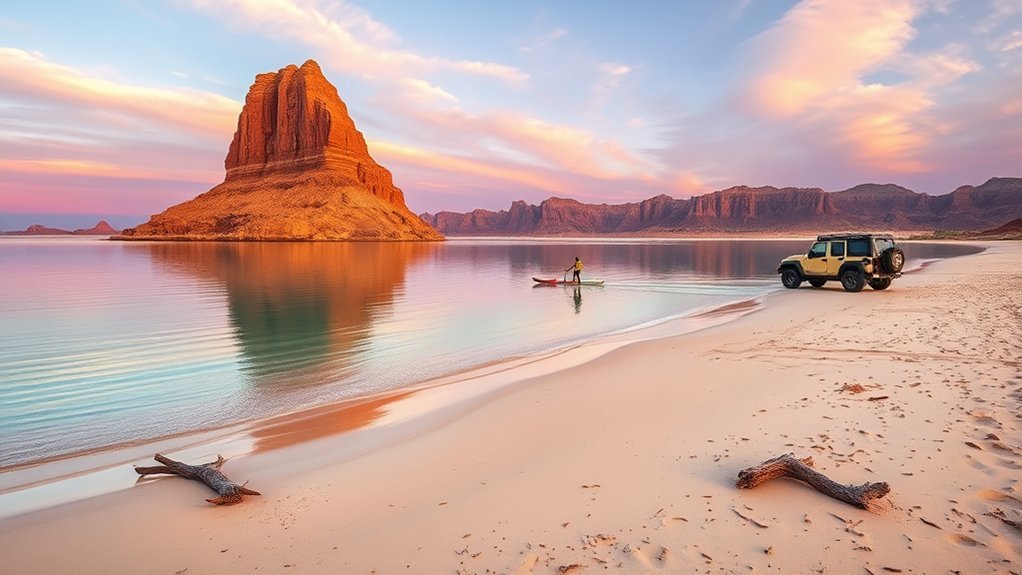
If you’re looking for a place where the desert meets the water and the horizon feels endless, Lone Rock Beach delivers — a wide, sandy crescent on the Colorado River framed by a solitary sandstone butte that’s visible from miles away. You’ll walk where sand softens to shoreline, watch kayaks drift past tawny cliffs, and feel the wind sketch ripples on the water. Bring a blanket, a cooler, and a camera; sunsets here turn the rock molten and make every moment cinematic.
| Sound | Feeling |
|---|---|
| Wind over sand | Calm anticipation |
| Lapping water | Quiet joy |
You can camp right on the shore, set up a fire, and fall asleep to stars without city light. Rangers patrol occasionally, but you’ll mostly have a peaceful stretch of river to yourself. Lone Rock is simple, raw, and utterly memorable — the kind of place that slows your breath and asks you to stay a little longer.
Navajo Village Heritage Center
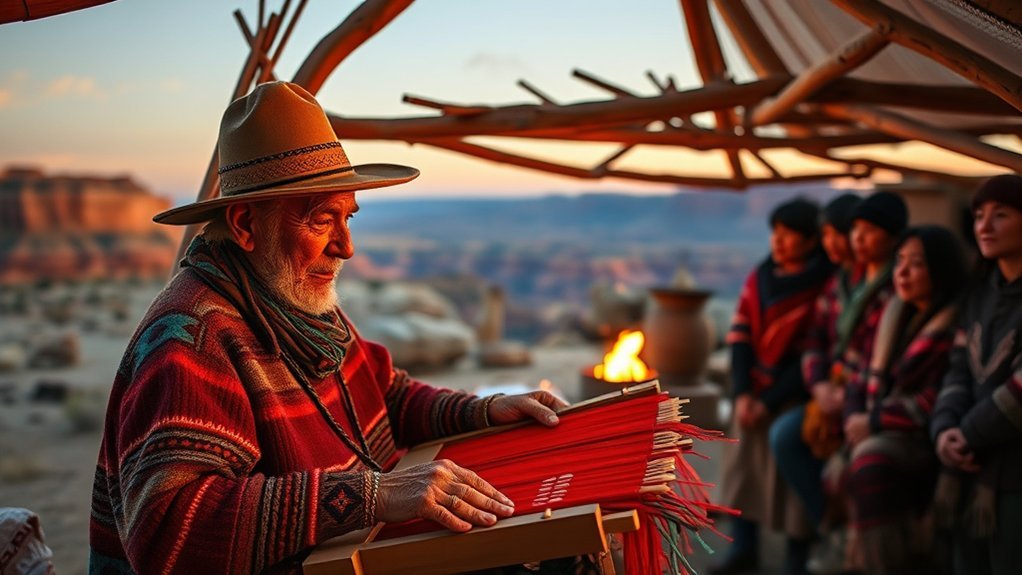
From the open shore of Lone Rock you can feel the presence of the land’s long stories, and a short drive brings you to the Navajo Village Heritage Center where those stories come alive. You step into a living mosaic: hogans, weaving demonstrations, and elders who speak in images and memory. Guides invite you to listen—each tale ties clan, landscape, and ceremony to the red cliffs you’ve been watching.
From Lone Rock’s shore, the Navajo Village breathes stories—hogans, weaving, elders guiding you into land and memory
You’ll engage directly with traditions that still shape daily life. Expect hands-on demonstrations, respectful conversation, and moments that shift your understanding from “sightseeing” to witness.
- Take a guided tour to learn clan histories and symbolism.
- Watch a weaver transform dyed wool into patterns tied to place.
- Attend storytelling or song to hear language carried across generations.
- Sample traditional foods and ask about ingredients and meaning.
You’ll leave not just with photos, but with a quieter sense of why this place matters.
Page Rim View Trail
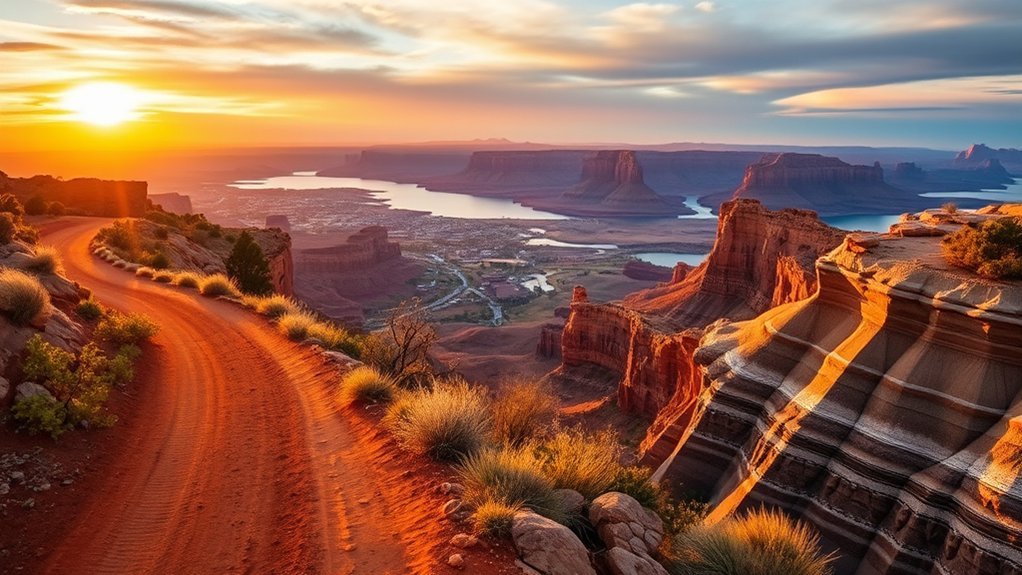
When you step onto the Page Rim View Trail, the rim opens up into a sweeping scenic walk that makes each turn feel like a new chapter. You’ll follow well-marked paths that hug the canyon edge, with pull-offs that beg for a pause and a photo. Plan to be here at sunrise or sunset—those light-filled hours turn the vistas into a storybook of color and shadow.
Scenic Rim Walk
On the Page Rim View Trail you’ll step onto a broad, windswept ledge that frames Lake Powell, sandstone spires, and the desert’s endless horizon like a living panorama. You’ll set off along the rim where scrub brushes whisper and the trail narrows, each turn revealing another carved ridge or distant canyon mouth. Walk steady; the path is exposed but well-marked, and every benchrock invites a pause to read the land’s geology. Bring water, sun protection, and curiosity—this route rewards quiet observation and small discoveries: fossil fragments, lichen patterns, bird silhouettes. Try this simple plan:
- Start at the trailhead early for cooler air.
- Move at an easy pace; stop for views.
- Note geological layers with a camera.
- Respect fragile desert plants and stay on the trail.
Sunset / Sunrise Views
As light tilts low and the air cools, the Page Rim View Trail turns into a stage where colors deepen and shapes declare themselves—gold spills across sandstone, shadows lengthen into ink, and Lake Powell reflects a last, molten ribbon of sky. You’ll hike easy switchbacks to a rim perch, breathe a wider horizon, and watch sun and canyon trade secret after secret. Sunrise offers cool clarity and bird song; sunset pours warmth and long silhouettes. Bring layers, a headlamp for return, and a camera with a spare battery. Plan for 45–75 minutes at viewpoints. Decide whether you want solitude or a shared spectacle—both reward you with panorama and that quiet, elemental hush.
| Best time | Experience |
|---|---|
| Sunrise | Crisp light, few people |
| Sunset | Warm tones, dramatic silhouettes |
Lees Ferry and the Colorado River
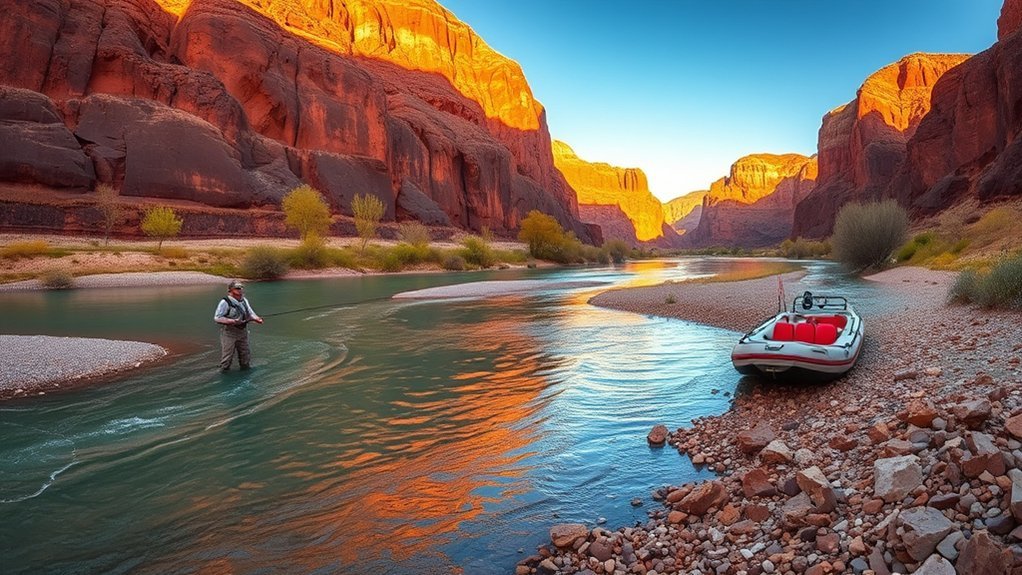
Slip down the riverbank at Lees Ferry and you’ll step into the gateway where the Colorado River eases out of the high country and into the Grand Canyon, a place packed with cowboy-turned-steamboat history and world-class trout fishing. You can feel the river’s scale here — wide, green, patient — and imagine steamboats nudging against the shore while anglers mend lines beneath cottonwoods.
You’ll find activities that suit both quiet curiosity and bold adventure:
- Rent a drift boat or join a guided float for mellow, scenic miles.
- Cast for rainbow and brown trout in riffles that pro anglers praise.
- Walk the historic ferry landing and read plaques about 19th-century river crossings.
- Launch multi-day downstream trips that begin where the canyon swallows the horizon.
Lees Ferry whispers stories of early pioneers and river guides; when you listen closely, you’ll leave with a clear map of why this stretch feels elemental and unforgettable.
Slot Canyon Hiking Near Page
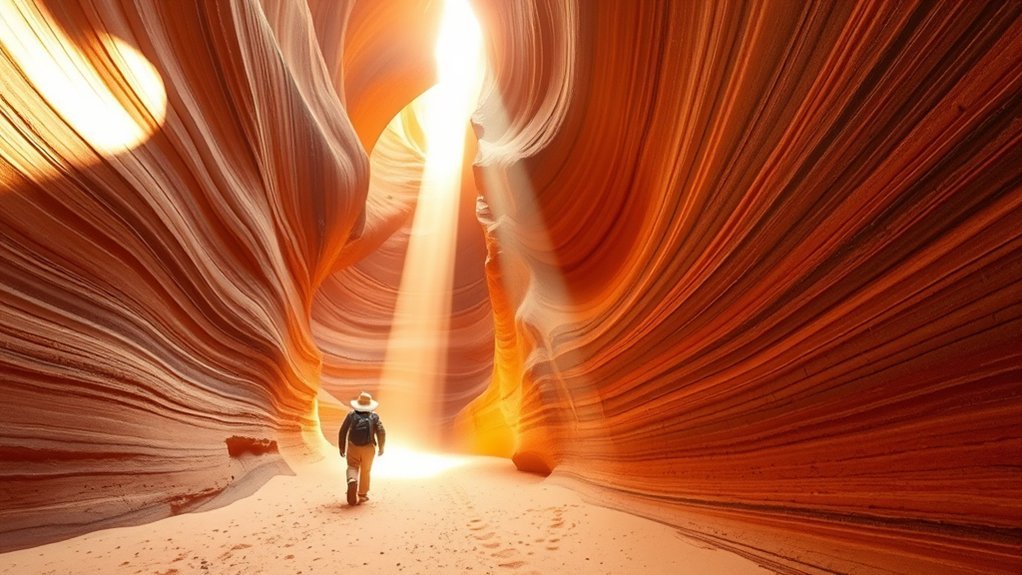
From the river’s gentle sweep to the cliffs’ carved veins, the landscape around Page invites a change of pace: narrow, sunlit slot canyons offer an intimate counterpoint to Lees Ferry’s broad calm. You’ll slip into sandstone corridors where light becomes a living thing, ribboning walls in gold and rose. Move slowly; the canyon tells its history through grain and shadow. Watch your step—sand and slickrock shift—and listen for distant bird calls that feel amplified in the tight space. Plan around flash floods; check forecasts and ask locals about recent rains. Bring water, a headlamp, and sturdy shoes; some squeezes demand patience and low shoulders. Photography rewards restraint—pick one frame and wait for the beam. Guided tours add safety and story, while solo bushwhacks yield discovery if you know route-finding. Below is a quick guide to help you choose a canyon and prepare.
| Canyon | Feature |
|---|---|
| Short slot | Easy squeezes |
| Technical slot | Narrow passages |
| Photogenic slot | Light beams |
| Backcountry | Longer routes |
North Wash and Wire Pass Trails
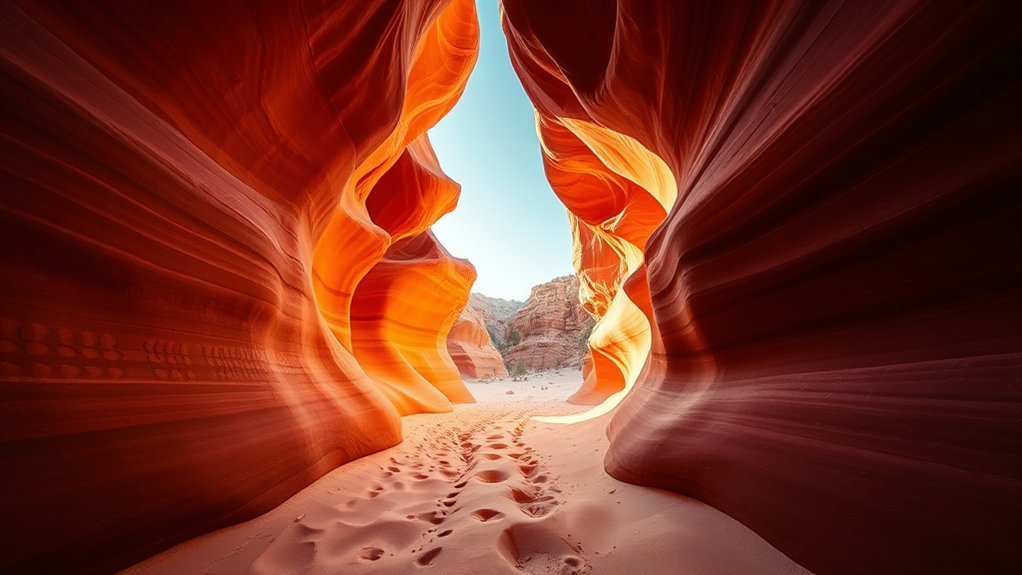
You’ll enter Wire Pass Slot through a narrow, sculpted corridor of orange sandstone that feels like walking into a hidden chapter of the desert. From there, the North Wash hike opens into broader washes and slickrock, so plan your route, water, and timing carefully to avoid heat and flash floods. Grab any required permits, tell someone your plan, and be ready for route-finding — the beauty here rewards preparation.
Wire Pass Slot Overview
If you’re heading into the North Wash, expect a short, dramatic slot that feels like stepping into a natural cathedral—narrow walls, sculpted sandstone, and light that slices through from above. You’ll move through tight passages where echoes tell stories of wind and water. The slot funnels your focus to texture, color, and the slant of sunbeams; every turn delivers a new frame for photos and quiet awe. Remember the approach is as much a part of the experience as the gorge itself.
- Arrival: park, scan the map, and sense the landscape tightening.
- Entrance: low, narrow, cooling light replaces open sky.
- Passage: squeeze, step, and study cross-bedded walls.
- Exit: a sudden widening, relief, and a final glance back.
North Wash Hike Tips
Like stepping into a story, the North Wash and Wire Pass trails demand attention to rhythm and detail—move deliberately, watch your footing, and read the landscape as you go. You’ll follow slickrock ribbons, cross sandy stretches, and slip into narrow walls that shift light like pages. Pace matters: shorter steps on loose gravel, wider ones on bedrock. Look for cairns and faint bootprints; they’re your plot points. Pack water in accessible pockets, wear grippy shoes, and bring a headlamp if you plan to explore darker slots. Pause often to note petroglyphs, subtle stratification, and tiny desert blooms. Leave no trace: take photos, not artifacts. These trails reward slow, attentive travel—stay present and the canyon will reveal its chapters.
Permits and Safety Notes
Because these narrow canyons are both fragile and popular, plan ahead and secure the required permits before you go: Wire Pass sits within BLM-managed land that requires a permit (and often a timed entry), while North Wash access may have its own restrictions or seasonal closures—check the latest BLM and Navajo Nation notices. You’ll feel the canyon close around you; respect fragile sandstone and stay on route. Pack water, tell someone your plan, and be prepared for sudden flash floods.
- Reserve permits early — weekends fill fast.
- Check weather and flash-flood warnings before hiking.
- Carry maps, GPS, and extra water for desert conditions.
- Follow Leave No Trace: pack out all trash, avoid carving or climbing soft walls.
Powell Museum of Natural History
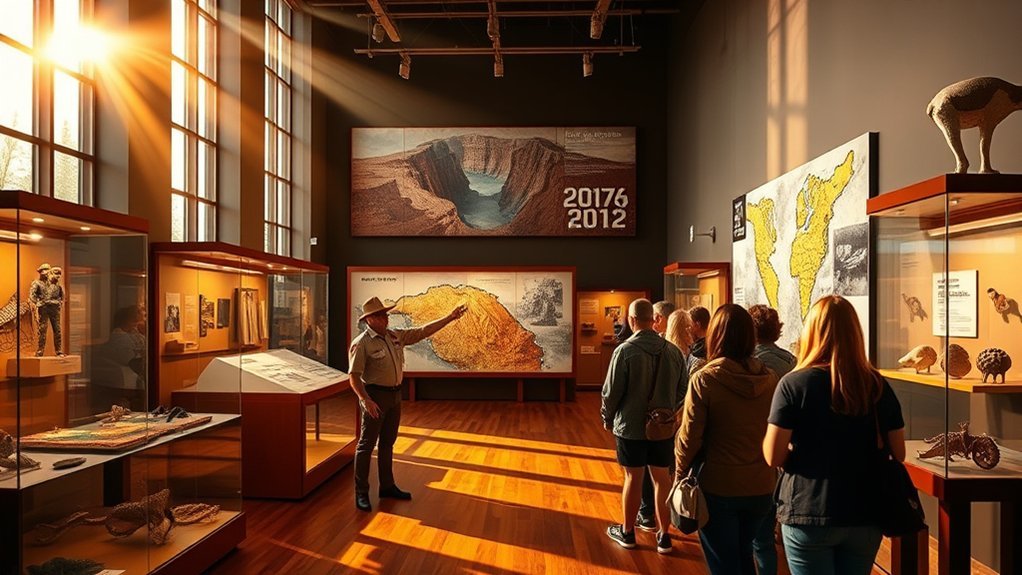
Step into the Powell Museum of Natural History and you’ll feel the desert’s deep time unfold around you—fossils, artifacts, and interpretive displays trace the Colorado Plateau’s geologic drama and the human stories tied to Lake Powell. You’ll move from ancient seas to sandstone cliffs as specimens and dioramas anchor complex geology in clear, approachable language. Touch-screen exhibits and field maps help you piece together how uplift, erosion, and water sculpted this landscape. You’ll also encounter Navajo pottery, pioneer tools, and archival photos that connect scientific history to local lives; docents often share anecdotes that make specimens feel personal. Don’t miss the rotating exhibits—faculty and students frequently showcase fresh research, so every visit can reveal a new discovery. Whether you’re a geology buff, a family with curious kids, or someone wanting context before heading into the canyon country, the museum equips you with stories and visuals that sharpen your sense of place and deepen your appreciation for Page’s layered past.
Alstrom Point Overlook
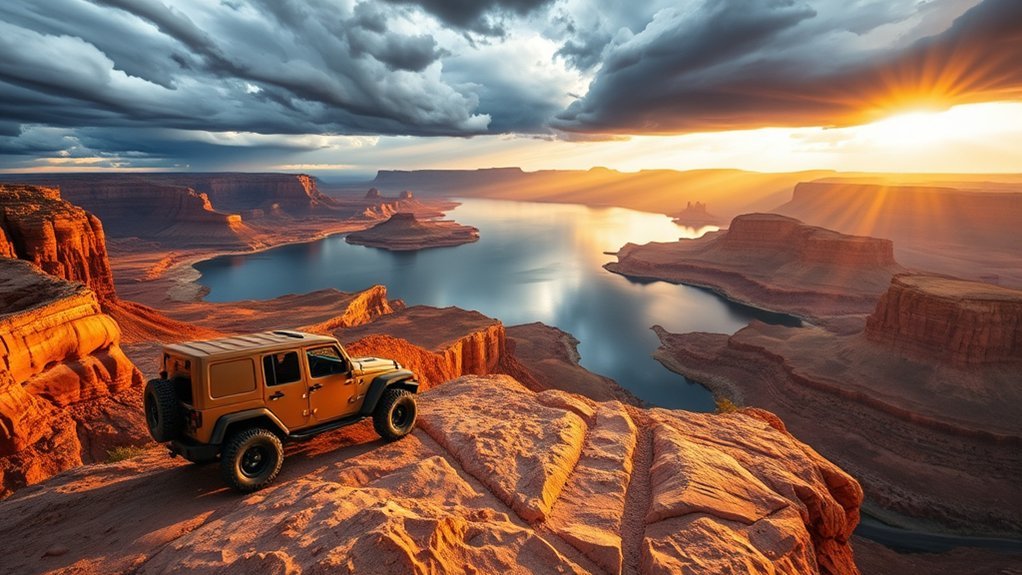
When you crest the narrow, unpaved road and the landscape suddenly opens, Alstrom Point commands your attention with a wide, plunging view of Lake Powell’s labyrinthine shoreline and the shoulders of Navajo Mountain beyond. You’ll step out into wind and light, feeling the scale — sandstone cliffs, water inlets, and islands folding into the horizon. The overlook isn’t polished; it’s raw, so you move carefully, camera ready, imagining sunrise painting the cliffs gold.
- Drive: high-clearance vehicle recommended — road is rugged and remote.
- Timing: dawn and dusk offer the best color and softer shadows.
- Safety: bring water, a map, and cell backup — services are limited.
- Photography: use a wide lens and bracket exposures for dramatic skies.
You’ll linger at the edge, mapping the maze below, letting the silence of space and water reset your sense of distance before you continue exploring Page.
Antelope Island State Park (Local Day Trip)
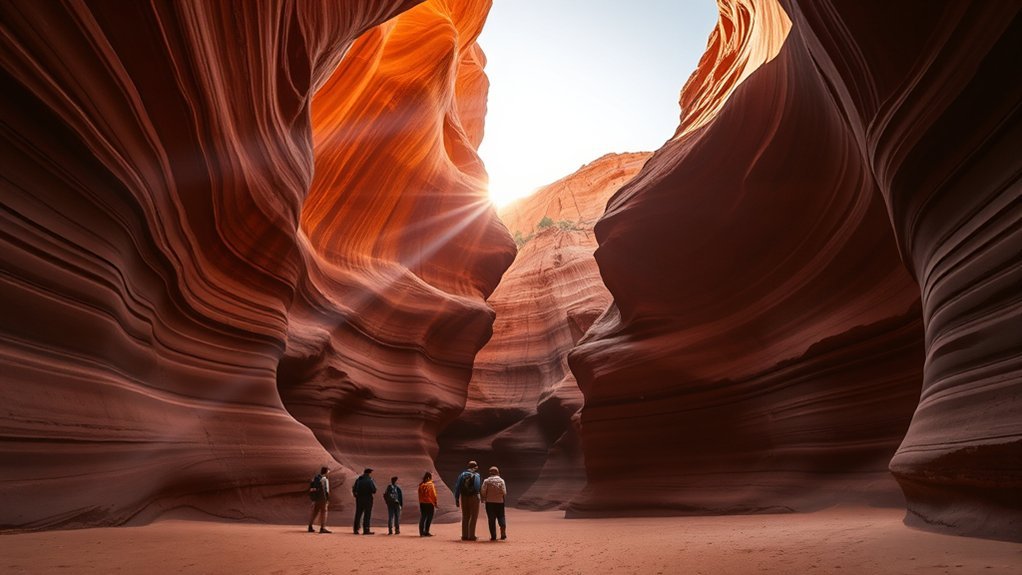
Although Antelope Island sits in the shimmering expanse of the Great Salt Lake just a short drive from Salt Lake City, you’ll feel transported to a rugged, windswept world where bison roam the sagebrush and shoreline vistas stretch into brilliant salt flats. You arrive via Causeway, wind tangling your hair as the island’s low hills rise ahead. Trails lace the landscape—easy boardwalks by the shore, steeper climbs toward Frary Peak—and each step changes the light on distant water. Keep binoculars handy: you’ll spot bison, pronghorn, and waterfowl against a backdrop of pink-hued salt crust. Picnic areas near Garr Ranch invite a slower pace; interpretive signs recount early ranch life and ecology, grounding your wander in place and time. Sunset is the island’s quiet spectacle—colors deepen, birds wheel, and the Great Salt Lake mirrors the sky. You leave with sandy shoes, sharper eyes, and a clear sense of why locals treasure this close, wild escape.
Horseback Riding Tours in the Desert
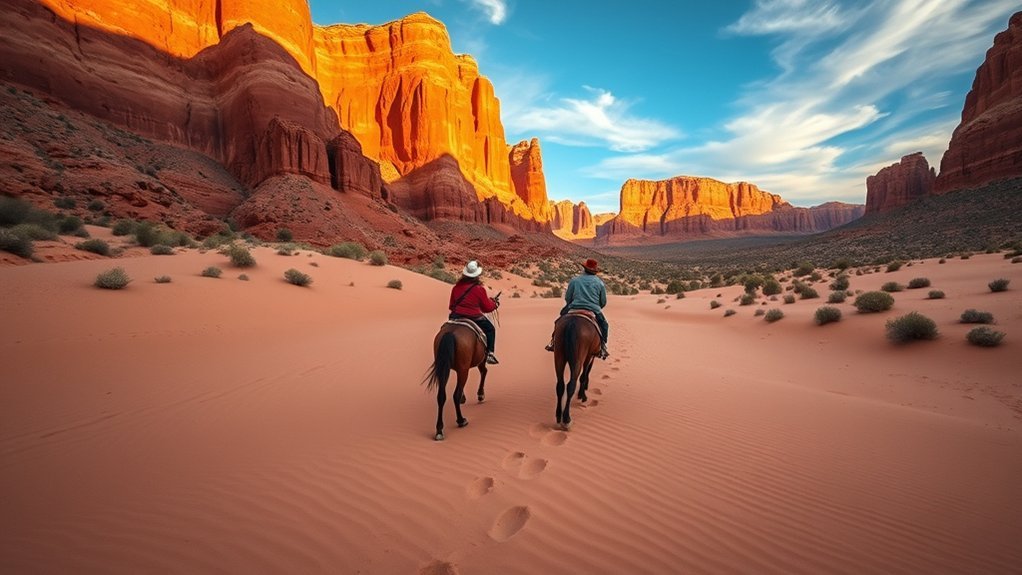
Sway with your mount as the sun warms red sandstone and your guide points out hidden washes, ancient petroglyphs, and the scrubby plants that anchor desert life; horseback tours turn the landscape into a slow, tactile story you feel in your saddle. You’ll move where vehicles can’t, following faint trails carved by water and time. The horse’s rhythm sets the pace for noticing small details — a lichen-streaked boulder, a raven’s call, the way light slices a canyon rim. Guides share geology, Navajo history, and safe riding tips, so you learn as you travel. Expect patient animals, shade breaks, and photo stops that feel earned.
Swaying in the saddle as sunlit redstone, guides reveal petroglyphs, hidden washes, and the slow rhythms of desert life.
- Choose a tour length: short sunset ride or multi-hour canyon loop.
- Wear closed-toe shoes, sun protection, and layered clothing.
- Ask about rider requirements and kid-friendly options.
- Book in advance during peak seasons for best times and guides.
Scenic Flights Over Page and Lake Powell
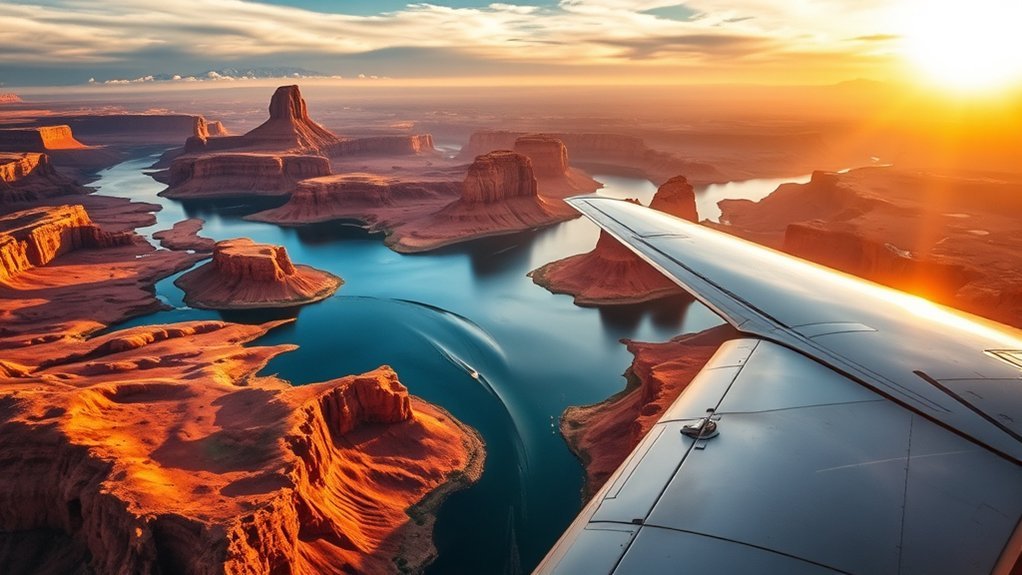
If you want to see the canyon’s scale and the ribbon of Lake Powell from above, a scenic flight gives you a perspective you can’t get on horseback or from the shore. You’ll climb into a small plane or helicopter, feel the lift, and watch sculpted sandstone, hidden alcoves, and the lake’s glassy inlets unfold. Pilots narrate routes, point out Navajo bridges, Glen Canyon Dam, and secret side canyons you can’t reach by road. The light shifts constantly; mornings cast long shadows, afternoons reveal color layers. You’ll understand why photographers rise before dawn.
| Flight Type | Highlight |
|---|---|
| Helicopter | Low passes, vertical views |
| Fixed-wing | Wider panoramas, smoother ride |
| Sunset tours | Golden cliffs, dramatic contrast |
| Photography | Extra time over key formations |
Book with a vetted operator, check weight and weather rules, and arrive ready to lean into the window for the shot that makes the landscape feel alive.
Kayaking and Stand-Up Paddleboarding on Lake Powell
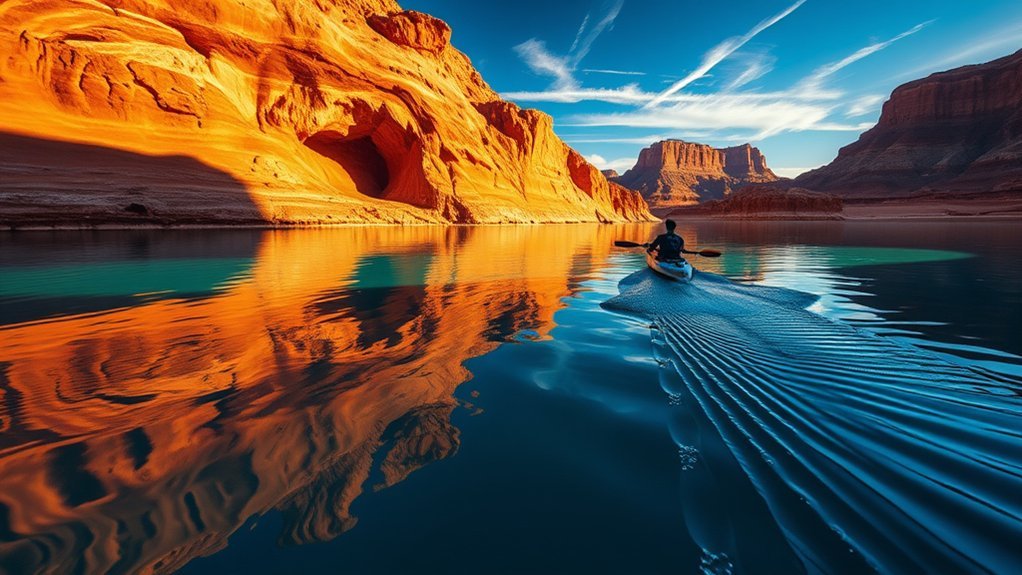
Set off from a hidden cove in a bright plastic kayak or on a quiet stand-up paddleboard, and you’ll slip into a world where sandstone cliffs rise like cathedral walls and the lake mirrors every shifting color of the sky. You’ll propel quietly along narrows carved by ancient water, glance into alcoves where petroglyph shadows fade, and feel the sun warm the water’s skin. Rentals and guided tours launch from marinas; choose a short paddle to a slot canyon or a full-day trip that threads through quiet inlets. Pack water, a light jacket, and a dry bag for your camera—wind can change suddenly. Consider these practical choices as you plan:
Set out from a hidden cove by kayak or SUP and glide beneath cathedral sandstone cliffs into serene, sun-warmed narrows.
- Half-day rental for a relaxed sampler
- Guided slot-canyon tour with local history
- Full-day loop to remote beaches and swimming spots
- SUP yoga or sunset glide for calm reflection
You’ll leave with sand between your toes, stories of hidden beaches, and a sharper sense of how vast and quiet this canyon-lake landscape can be.
Sunset Photography at Glen Canyon Overlook
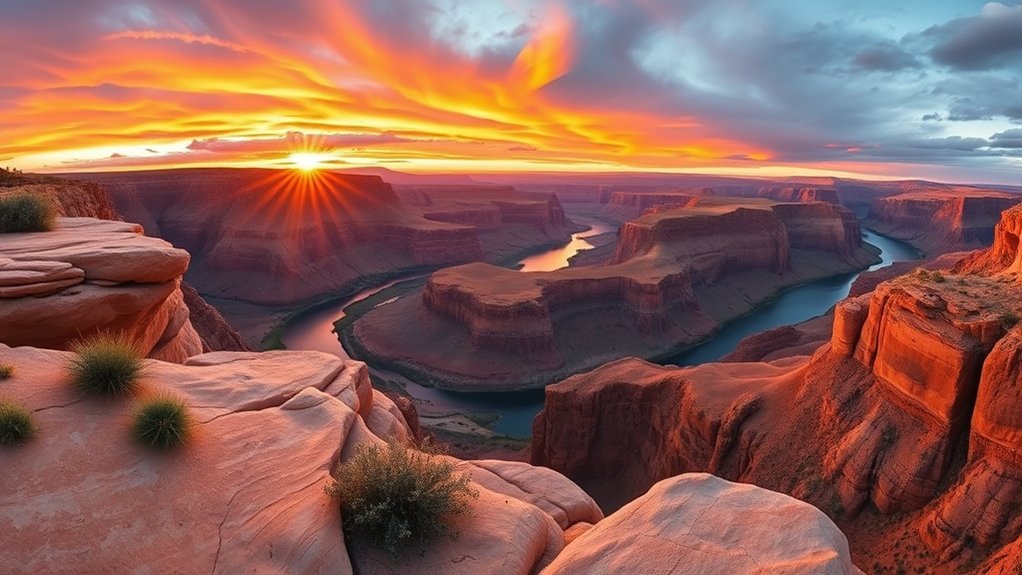
After a day of paddling through glassy narrows, you’ll want to climb to Glen Canyon Overlook before the light fades—the rim gives you a wide, cinematic view where the river carves a ribbon of shadow through rust-colored cliffs. You’ll time your arrival to watch the sun lower, then change plans as golden tones melt into pinks and purples. Set up on stable rock, frame the river bend with a telephoto to compress layers or go wide to capture sweeping canyon geometry. Use a tripod, low ISO, and a slow shutter to smooth any breeze-swept vegetation; bracket exposures to preserve highlight detail on sunlit sandstone and shadowed walls. Pay attention to reflected light that warms cliff faces after the sun dips. Let a single sequence guide you—foreground stones, midground river, distant rim—and adjust as color shifts rapidly. When the last light lingers, take a few quiet moments to absorb the scene; the images will follow.
Stargazing and Night Sky Photography
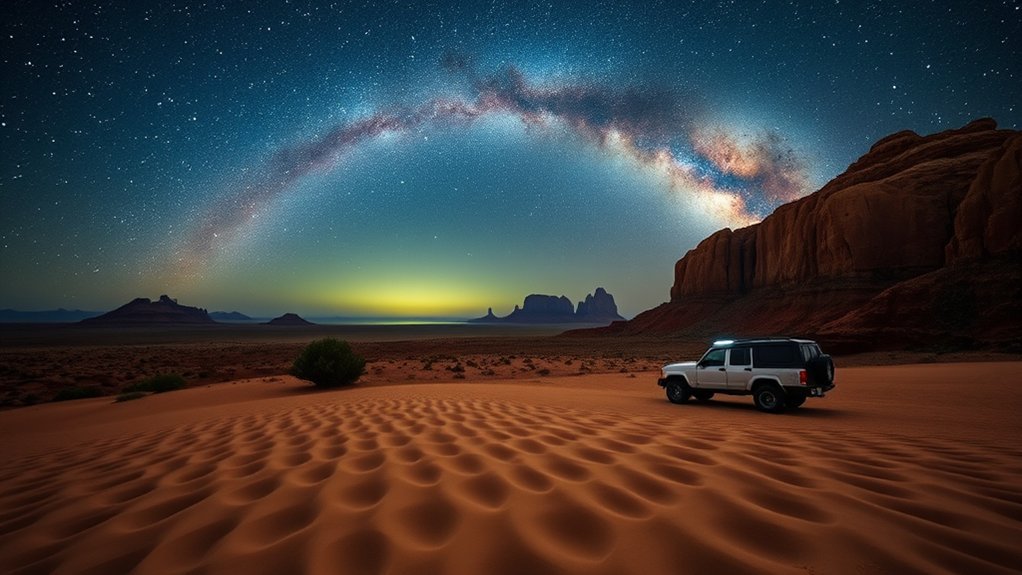
Gazing upward at Page’s dark skies feels like stepping into a living map—constellations, the Milky Way’s broad sweep, and satellites tracing slow arcs all become part of the night’s story you can both read and record. You’ll find spots along Lake Powell and the overlooks where light pollution fades, and the canyon’s silhouette becomes a stage for stars. Set up your tripod, frame a foreground rock or boat, and use long exposures to pull faint nebulae into view. Watch how your breath fogs in the cold and the shutter captures time you can’t see.
- Choose a moonless night and scout a foreground at golden hour.
- Use wide aperture, low ISO, and 20–30s exposures; bracket for safety.
- Bring headlamps with red mode, warm clothing, and spare batteries.
- Try star trails, Milky Way arcs, and anchored foreground lighting.
You’ll leave with images and a quiet sense that the universe paused for you.
Frequently Asked Questions
Where Can I Find the Nearest Grocery Store and Supplies in Page?
You’ll find the nearest grocery options downtown: Safeway and City Market stock basics, snacks, and camping supplies; nearby Ace Hardware and outdoors shops fill gear gaps. You’ll grab supplies quickly and get back exploring.
What Are Pet-Friendly Accommodations and Rules in Page?
Think of your pup as a VIP guest; you’ll find many hotels and rentals that welcome pets with modest fees, leash rules, size limits, and cleaning expectations. Read policies, book in advance, and bring bedding, water, and patience.
How Is Cell Phone and Internet Coverage Around Page?
Coverage’s spotty outside town: you’ll get reliable 4G/5G in Page and at major hotels, but signals weaken at Antelope Canyon, Horseshoe Bend, and remote trailheads — you’ll download maps beforehand and expect intermittent service.
Where Can I Buy or Refill Gasoline Near Main Attractions?
You’ll find gas stations in Page’s center—Safeway Fuel, Chevron, and Maverik—near Highway 89. You’ll refill easily before visiting Horseshoe Bend or Antelope Canyon, with convenient pumps, snacks, and helpful locals to point the way.
What Are Local Medical Facilities and Emergency Numbers in Page?
Call 911 for emergencies; Page Police (928-645-4091) and Page Fire/EMS respond quickly. For urgent care, you’ll use Northern Arizona Healthcare’s Page Clinic (928-645-5660) or Flagstaff hospitals for advanced treatment.
Conclusion
You’ve wandered red-rock cathedrals and watched the Colorado braid its way through stone; now carry those views with you like a polished river pebble in your pocket. Let Antelope’s light beams, Horseshoe Bend’s thunder, and Lake Powell’s quiet coves settle into your bones. Come back with a map of memories: guided canyon whispers, sunrise flights, and starlit skies will keep calling you until you return to Page’s wide, echoing heart.

